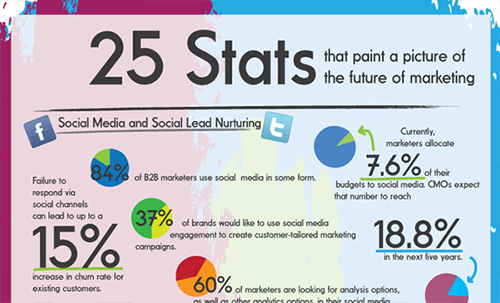25 Stats on the Future of Marketing [Infographic]
Not sure where marketing is headed? Not sure if it’s for you, or if it would work for your company? Check out our infographic below and check out the stats for yourself. Originally posted by Hubspot, we took and compiled recent statistics and made a fancy infographic out of them to bring the information right to you.
The main categories in these stats are: social media, personal and dynamic content, email marketing, analytics and integration, as well as mobile marketing and apps.
Why all this is important:
Let’s start with social media. Social media is becoming increasingly important in today’s marketing world because so many people use it on a day-to-day basis. Because of this, many more marketers are becoming active in social media. Gone are the days where a company just needs to have a page on a social media website, they actually need to be active on social media and working to engage their audiences. What the stats also show, though, is that marketers and CMOs are looking for one central place where they can do this–instead of having to hop from page to page and outlet to outlet, marketers would love to just have one go-to platform where they can do it all. Also, a need for good social media analytics is on the rise–marketers want to see how their clients are interacting via social outlets and how they can best harness these to work with their customers.
Onto personal and dynamic content, it’s becoming very clear that people want targeted content. They want what’s relevant to them, not a broad based advertisement–they want to see exactly what you can offer them as an individual. Because of this, so many consumers are willing to share personal information such as age and location in order to get more relevant content. Also, though, they don’t want information overload; they want just enough but not too much. Too much advertising is a cause of unsubscribing to or ignoring emails/content. These stats not only show these facts, but also that marketers are looking for a system to help them personalize their communications with customers and to help them to know when to send these communications.
Speaking of emails, let’s get on to email marketing and automation. From the personalization stats, it’s already clear that customization is something marketers need to do. Email marketing has somewhat fought against this, though, as marketers can just draft a base email with a broad advertisement and send it to all of their clientele. What the stats say marketers and advertisers are now looking for is a marketing platform that will help them divide their contact lists of customers into more segmented, customized lists. For example: customers who shop once a month, customers that shop a few times a month, and customers that shop weekly. The system would then help them send different personalized emails to each of these groups. Marketers are also wanting this system to help them send off marketing campaigns on a scheduled basis. Overall these stats show that email marketing today is all about finding what’s valuable to your customers and giving it to them in a way that helps benefit your business.
So if you’ve got content that’s well customized to your clients, how will you know it’s working? That’s where marketing analytics and integration comes in to play. Integration is a key part of marketing success. To be successful and to best create targeted, personalized content, marketers and advertisers need data! That data will help you know where to focus your marketing efforts. After initial data and statistics help target content, user and usage data helps to see how and where your content is working (or not working). Having a system that collects and analyses data will help make sure that your marketing budget is being used efficiently and effectively.
Another must-have for today’s customer is most certainly their mobile phone. In today’s world almost everyone has a phone, and of those that do have phones, a good number of those have smartphones. Many of these mobile users are seeing and interacting with advertisements via their mobile devices. Unfortunately, though, so many websites aren’t mobile friendly. A good customer experience is always a goal that should be kept in mind, especially on mobile. Marketers, though, are also looking for options to simplify the mobile experience. Having a mobile application that allows them to see their data analytics and automation software will help marketers see how their carefully planned out strategies are getting the job done. Having this sort of mobile app would let them stay up-to-date on how many leads are being generated and how many customers are being converted when they’re out and about.
So what exactly are all these stats saying? In order to meet needs, create ideas and personalize them, as well as get these all out to the customer, each of the different parts of marketing need to be brought together. From email marketing, social media, to mobile marketing, each of these has something special to offer, but could likely do it better if marketers were given a platform for each that would help them to know their clients and customize each type of content for them. Each of these can help the other to create an awesome, powerful marketing campaign.
These stats make it clear, though, that mobile marketing isn’t going anywhere but up. Need a little help with your mobile marketing? Give us a yell and let us help you get up and going.
Click the image below to see the infographic!



